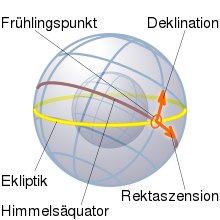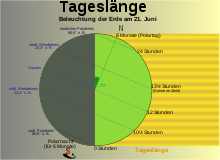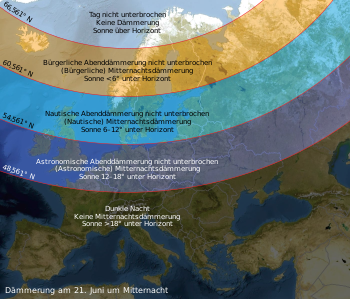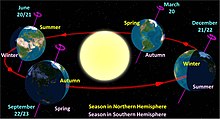Solstice
![]()
The title of this article is ambiguous. For other meanings, see Solstice (disambiguation).
![]()
Winter solstice is a redirect to this article. For other meanings, see Winter solstice (disambiguation).
A solstice, also called solstitium (Latin for "solar standstill"), occurs twice in the course of the year. On this date, the highest or lowest midday position of the sun is reached in geographical latitudes outside the tropics between the tropics:
- At the summer solstice, the Sun has its greatest noon altitude above the horizon - in the northern hemisphere of the Earth on June 20, 21 or 22; in 2020, the summer point was passed on June 20 at 23:44 CEST, in 2021 it was on June 21 at 05:32 CEST.
- At the winter solstice, the Sun has the lowest noon altitude above the horizon - in the northern hemisphere of the Earth on December 21 or 22; in 2019, the winter point was passed on December 22 at 05:19 CET, in 2020 on December 21 at 11:02 CET.
In the southern hemisphere the situation is reversed: during the northern winter it is summer in the southern hemisphere, and vice versa. Over places on the equator the apparent path of the sun at the equinoxes passes exactly through the zenith; but during the northern summer it passes somewhat more northerly, and during the southern summer somewhat more southerly, in both cases therefore not quite as high as the zenith.
Twice in the course of a tropical year, the Sun takes up positions of greatest angular separation in its apparent motion along the ecliptic north or south of the celestial equator. The two reversal points are also called solstices and, depending on the hemisphere, are referred to as the summer or winter solstice. After passing these points of extreme declination - at the summer and winter points, respectively - their position approaches the celestial equator again, which is reached at the vernal and autumnal points. Together with these two equinoxes (equinoxes), the two solstices terminate the astronomical seasons.

At the solstices, the ecliptic, as the apparent path of the sun on the celestial sphere, has the greatest angular distance from the celestial equator; it intersects it at the vernal equinox.

The length of day on 21 June at different latitudes
Astronomical basics
Definition
The exact definition is: The solstices are the times when the apparent geocentric ecliptical longitude of the sun is 90° or 270°.
- Apparent means: taking aberration and nutation into account.
- Geocentric means: seen from a fictitious observer at the center of the earth. The definition is therefore independent of the location of a real observer; the solstices therefore occur worldwide at the same time (which, however, corresponds to different times depending on the local time zone).
A simple planetary geometric definition is: Solstice: The angle sun center-earth center-earth pole is extreme. Two cases: Extreme angle minimum -> summer solstice; extreme angle maximum -> winter solstice; so the two Earth hemispheres have both cases simultaneously, alternating. (Equinox: The angle sun-center-earth-center-earth-pole is a right one).
The two times coincide, except for a few minutes, with those times when the Sun reaches its greatest northern or southern declination - about 23° 26′ 20″ - and thus its northernmost or southernmost position on the celestial sphere. The small time difference results from the fact that it is actually the barycenter of the Earth/Moon system that moves uniformly around the Sun in the Earth's orbital plane (ecliptic), while the Earth itself orbits this common center of gravity and is usually slightly above or below this plane. Seen from the geocenter, the Sun therefore does not run exactly on the ecliptic (it has a non-zero ecliptic latitude). Therefore, on the one hand, it does not pass exactly the northernmost or southernmost point of the ecliptic, and on the other hand, its variable ecliptic latitude means that the maximum declination is not usually assumed to be exactly at the solstice points.
Conclusions
The solstices mark the beginning of the astronomical summer or winter. When the Sun reaches its greatest northern or southern declination of 23.4°, it is perpendicular to the so-called tropics of the Earth (namely the parallels of latitude at 23.4° north or south). So it stands
- on 21 or 20 June above the Tropic of Cancer (summer solstice in the northern hemisphere, winter solstice in the southern hemisphere),
- on 21 or 22 December over the Tropic of Capricorn (winter solstice in the northern hemisphere, summer solstice in the southern hemisphere).
The following applies to both hemispheres: At the winter solstice the sun reaches its lowest point in the course of the year in relation to the meridian passage. At this time there is the shortest day and the longest night, because the greater part of the daily solar orbit lies below the horizon. Conversely, the sun reaches its highest position at the summer solstice. At this time there is the longest day and the shortest night, because the greater part of the daily solar orbit lies above the horizon.
Near the polar circles there is a day without sunrise at the winter solstice and a day without sunset at the summer solstice (midnight sun, "white nights"). Further to the pole, there is a polar day for weeks or months, or a polar night at the other pole. During these periods without twilight, the daily path of the sun lies completely above or below the horizon.
Between the solstices, the sun crosses the celestial equator and then stands vertically above the earth's equator. These times are the equinoxes or equinoxes. Equinoxes and solstices represent the beginning of the respective astronomical seasons.
Although the day of the winter solstice is the shortest day, the earliest sunset in the northern hemisphere occurs about ten days earlier and the latest sunrise about ten days later. The reason for this is the equation of time. At the summer solstice in the northern hemisphere, this effect is analogous to about four days.
Date
Because the solar year is almost six hours longer than the calendar common year with exactly 365 days, the time of the solstices shifts in each year by almost six hours to a later time. Since in leap years such as 2016, 2020 and 2024 (highlighted in bold in the table) a leap day is inserted in February, the date given in the calendar is then one day earlier than that of the previous year.
In the Central European Time Zone, the summer solstice currently falls on June 21. In the 20th century, it could also occur on June 22. In the 21st century, starting in 2020, it will sometimes be on June 20 because the leap rule (365.2425 days) can only approximate the actual length of the year (365.2422 days). Without the Gregorian calendar reform, its date would shift by seven to eight days per millennium. This shortening took place by the fact that - deviating from the leap rule of the Julian calendar - the secular years (that are years, whose number is divisible by 100) receive no more leap day, unless the year number is divisible by 400.
| Year | Summer Solstice | Winter Solstice | ||
| 2015 | June 21 | 18:38 CEST | December 22 | 05:48 CET |
| 2016 | June 21 | 00:34 CEST | December 21 | 11:44 CET |
| 2017 | June 21 | 06:24 CEST | December 21 | 17:28 CET |
| 2018 | June 21 | 12:07 CEST | December 21 | 23:23 CET |
| 2019 | June 21 | 17:54 CEST | December 22 | 05:19 CET |
| 2020 | June 20 | 23:44 CEST | December 21 | 11:02 CET |
| 2021 | June 21 | 05:32 CEST | December 21 | 16:59 CET |
| 2022 | June 21 | 11:14 CEST | December 21 | 22:48 CET |
| 2023 | June 21 | 16:58 CEST | December 22 | 04:27 CET |
| 2024 | June 20 | 22:51 CEST | December 21 | 10:20 CET |
| 2025 | June 21 | 04:42 CEST | December 21 | 16:03 CET |
| 2026 | June 21 | 10:24 CEST | December 21 | 21:50 CET |
| 2027 | June 21 | 16:11 CEST | December 22 | 03:42 CET |
For more details, see the article Season.
Winter point and summer point
At the moment of the winter solstice, the Sun is located in comparison to the background stars in the so-called winter point - one of the two points of the ecliptic that are exactly 90° away from the vernal point (right ascension = 18h). It is currently located in the constellation Sagittarius (lat.: sagittarius); the galactic center is also located approximately in this direction.
Similarly, at the moment of the summer solstice, the Sun is in the so-called summer point (right ascension = 6h) in the constellation of Taurus.
Due to the precession of the Earth's axis, the winter point and the summer point move once through the entire zodiac in the course of 25,780 years (cycle of precession). Thus, in ancient times, the winter point was still in the constellation of Capricorn (hence "Tropic of Capricorn") and will move to the constellation of the Serpent Bearer in about 300 years.
In early antiquity, the summer equinox was located in the constellation Cancer (hence "Tropic of Cancer"), and its migration is shown in the following table over an entire cycle of precession. If we take the modern boundaries of the constellations as a basis, then it is located in the following constellations:
| Constellation | Sector | Transit time | Admission | Middle | Exit |
| Shooter | 33,3° | 2380 years | 13030 BC | 11840 B.C. | 10650 BC |
| Serpent Bearer | 18,6° | 1340 years | 10650 BC | 9980 BC | 9310 BC |
| Scorpio | 6,7° | 480 years | 9310 BC | 9070 BC | 8830 BC |
| Libra | 23,0° | 1650 years | 8830 BC | 8005 BC | 7180 BC |
| Virgin | 44,1° | 3160 years | 7180 BC | 5600 BC | 4020 BC |
| Lion | 35,7° | 2570 years | 4020 BC | 2735 BC. | 1450 BC |
| Cancer | 20,1° | 1440 years | 1450 BC | 740 BC | 10 BC |
| Twins | 27,9° | 2000 years | 10 BC | 990 A.D. | 1989 AD. |
| Taurus | 36,7° | 2620 years | 1990 A.D. | 3300 AD | 4610 A.D. |
| Aries | 24,7° | 1770 years | 4610 A.D. | 5495 A.D. | 6380 A.D. |
| Fish | 37,2° | 2670 years | 6380 A.D. | 7715 A.D. | 9050 AD |
| Aquarius | 24,0° | 1710 years | 9050 AD | 9905 A.D. | 10760 A.D. |
| Capricorn | 28,0° | 2010 years | 10760 A.D. | 11765 A.D. | 12770 AD |
| Shooter | 33,3° | 2380 years | 12770 AD | 13960 A.D. | 15150 AD |
At an angle of 90° to the summer point and winter point lie the vernal point (right ascension = 0h) and the autumn point (right ascension = 12h), where the sun is located at the equinox.
Solstice line
The line connecting the positions of the earth at the time of the summer solstice and the winter solstice is called the solstice line. So this line passes through the middle of the sun, its extension outside the earth's orbit through the summer point and the winter point. It is perpendicular to the equinoctial line.

The Earth's orbit with equinoctial (green) and solstital (red) lines, as well as the elliptical major axis (turquoise) with aphelion and perihelion.

The dawn in Europe on a June 21

Annual cycle of the earth around the sun. Far left: Summer in the northern hemisphere. Far right: winter in the northern hemisphere.
Questions and Answers
Q: What is a solstice?
A: A solstice is an astronomical event that happens twice each year when the Sun reaches its highest position in the sky as seen from the North or South Pole.
Q: What is the significance of the day of the solstice?
A: The day of the solstice is either the "longest day of the year" or the "shortest day of the year" for any place on Earth, because the length of time between sunrise and sunset on that day is the yearly maximum or minimum for that place.
Q: Where does the name "solstice" come from?
A: The name "solstice" is derived from the Latin words sol (“sun”) and sistere (“to stand still”).
Q: What happens during the solstice?
A: During the solstice, the Sun stands still; that is, the seasonal movement of the Sun's path comes to a stop before reversing direction.
Q: When does the Northern Solstice occur?
A: The Northern Solstice occurs in June, when the sun is at its highest point seen from the North Pole.
Q: When does the Southern Solstice occur?
A: The Southern Solstice occurs in December, when the sun is at its highest point seen from the South Pole.
Q: What connection do the solstices, together with the equinoxes, have with the seasons?
A: The solstices, together with the equinoxes, are connected with the seasons. In some cultures they mark either the beginning or the middle of summer and winter.
Search within the encyclopedia